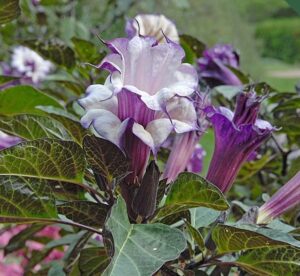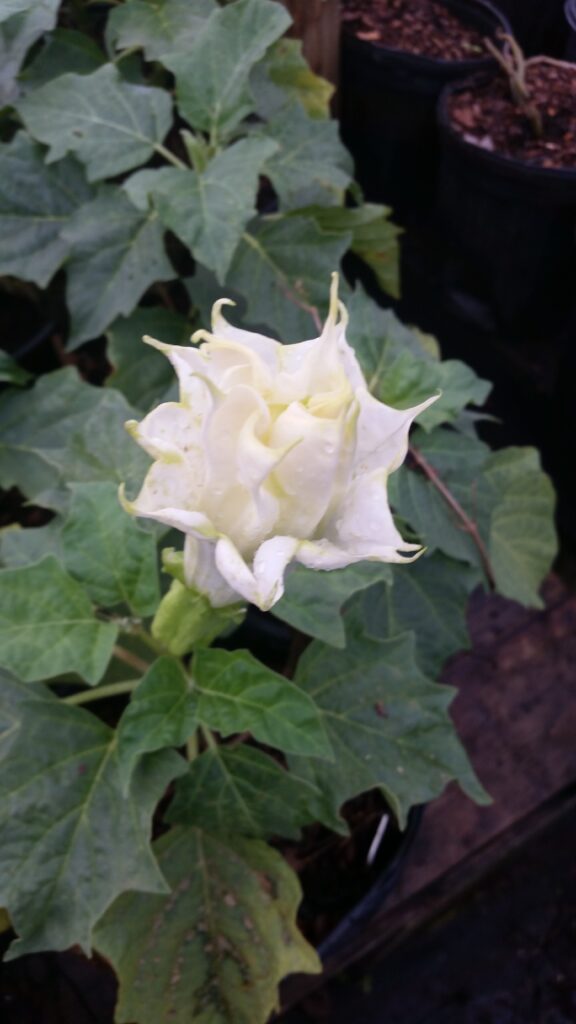S & J Nurserys Guide to Growing
Devils Trumpet Shrubs
for Northeast Florida, Jacksonville | St. Augustine area Landscapes
(Datura spp.)
Origins and Best Use of Angels Trumpet Flowers / Brugmansia spp. for the Northeast Florida Jacksonville | St. Augustine area home Landscape:

– Devils Trumpets are truly a tropical plant selection. They are cold sensitive in North Florida and only considered a root hardy plant selection, meaning they will regrow from the root system following frost damage to the stems and leaves. Although in the right microclimates, and in the warmer areas of our range here like near the Intercoastal or beach/ river/ South Jax and St. Augustine areas these plants may sustain minimal winter damage during more mild winter seasons. Expect to protect these shrubs form frosts. Most geographical locations would consider datura plants to be annuals and replant each season from seeds. To many a gardeners delight, Datura often pop up as volunteers from seeds dropped by the plant from the previous growing season.
– Origins of the datura spp. are still unconfirmed as are the number of species within the genus Datura, some sight only 9 while others list 14, and classification of the Datura plants seems to be complex as new species are still being reclassified as variants of already documented species.
– Use in areas of the garden that will be out of the way from children or pets garden areas as an ornamental flowering shrub, also makes an excellent potted plant.
Foliage of the Devils Trumpet
– The plant is evergreen in frost free areas ( zones 10-11 and will receive cold damage on the foliage in a frost. They should be protected when temperatures drop to 32 degrees or can be left to winter and regrow in the spring and summer months the following year. Herbaceous annuals or short lived perennials in more temperate zones.( Z 6-9) Large 8-12 inch deep olive green leaves.
– As with all sub tropical plant selections, they are particularly responsive to their individual planting location. When planted on the south side of the house away from north winds, or where receiving some frost protection from larger trees or nearby buildings. you may get only foliar damage. If planted into open exposed areas in full sun you may get leaf and stem damage. If in a protected area you may get no damage at all. Utilize your yards frost free microclimates for all of your tropical and subtropical plant selections.

Blooms of the Devils Trumpet / Datura :
– Blooms are held mostly upright above the branches during summer and fall are make such a stunning display. The trumpet shaped blossoms may be 6-12 inches in length and come in shades of white, purple and yellow. Blooms may be single double and even triple. They are often confused with Angels Trumpet plants ( Brugmansia) but datura normally is a bushier shorter shrub habit plant while most Brugmansia are taller ornamental small scale tree like plants with downward hanging blooms. Clever right? Easy way to tell which one you are looking at… Whos blowing those horns? Although I feel a bit guilty giving the gorgeous Datura shrubs such a bad association, after all their chemical compounds are the same but alas they get the worst end of the “bad plant stick”. And for those of you that are interested in taxonomy, some confusion among the genus may come from the fact that Brugmansia was indeed first classified as Datura by Linneaus and was later taken out of Datura and named after Dutch naturalist Sebald Justinus Brugmans.
Preferred Exposure for Devils Trumpet / Datura:
– Devils Trumpet will grow in full sun situations or part sun / shade locations in the Norhteast Flroida landscape. I find planting them in morning sun and afternoon shade, or morning shade and afternoon sun Ideal for flowering. Filtered light under taller shade trees like Pines, oaks or Maples is also ideal. Plants may have a bit of a bloom reduction in lower light areas under thick canopy trees but will be better protected from damaging winter frosts so there is a decent trade off value there.
– Best if planted on the south side of the house away from cold north winds, up next to a fence or near the foundation of a home or other building, or near larger shade trees that will protect these tropical plants from frost. Or plant on the west side of a home or building.
Soil Preference / Salt tolerance of the Devils Trumpet Tree:
– The plant prefers moist, well-drained, fertile, soil that has high organic matter content. Amend with compost when planting into dry sandy soils.
– poor salt tolerant
Size and Growth of the Devils Trumpet / Datura:
Size: most selections reach heights of 4-6 ft in height and 2-3 ft in width if left unpruned to grow up as a small scale ornamental tree .
Growth Habit: Rather upright when young develops a naturally rounded canopy with some pruning for fullness. Responds well to harsh prunings so don’t be afraid to trim when needed.
Growth Rate: Fast growing plant, expect approximately 1-2 ft of growth annually in the first few seasons and an established plant that burns to the ground in winter can regrow easily from its mature root system to 6 ft and blooming by the end of the summer months.
Care of the Devils Trumpet / Datura in the Northeast Florida Landscape:
– Amend sandy soils generously with compost to help your Devils trumpet plants get established quickly.
Here is a link to S & J Tree Farm and Nurseries Guide to Planting Your Plants into their New Home
– Water every day during the establishment period after planting in the garden from an S & J Nursery container. Be sure to continue supplemental irrigation during the hot summer months during prolonged droughts. Here is a link for S & J Tree Farm and Nurserys information on how to water your newly installed plantings in the Northeast Florida landscape
– Fertilize each year just after trimming in the spring after a cold recovery or in summer with a good shovel full of garden compost or use Osmocote or another slow release plant food spring, summer and fall.
– When temperatures drop under 32 degrees you may opt to protect your foliage and or stems from severe frost damage by throwing a blanket or other breathable fabric over the top of the plant making sure the edges touch the ground to trap in the heat from the soil.
– Make your last summer pruning in August giving your Angels Trumpet tree ample time to recover growing new foliage that will harden off before winter arrives for us here in late December. Pruning too late into the fall will cause flushes of cold sensitive new growth that is sure to freeze during even a light frost that hardened off foliage would not be affected by.
– DO NOT REMOVE WINTER BURNT FOLIAGE UNTIL ALL DANGER OF FROST HAS PASSED. Be sure not to remove any stems or leaves from the plant until we have reached the last average frost date and there are no late freezes being predicted. ( mid February for Northeast Florida is the average last frost date) Trimming burnt foliage and stems before then will leave bare branches deeper on the plant exposed to cold temperatures that would have been protected by those same stems and foliage if left unpruned and most often results in loss of the plant entirely.EditAngels Trumpet Flower Brugmansia

